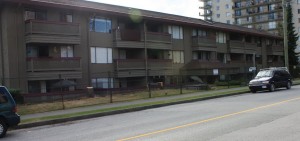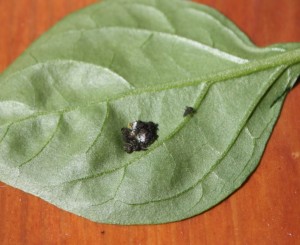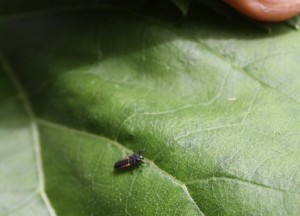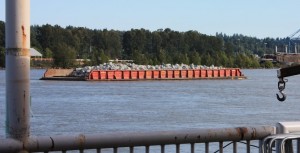Tag: Acting Locally
Metering Time
Call me a conservative, I think this is a good idea.
Water is a subject that raises passions in Canada, partly because we have so much of it, partly because we do such a poor job protecting it. Much like with electricity, good planning decades ago got us used to a plentiful supply of cheap water, and now to suggest we can’t have all we want, or that we might have to pay more for it? Well, that is the kind of thing that loses people elections.
But I’m not running for anything, so I’ll say it: we need to start paying for our water.
It is true that Metro Vancouver has a large supply of very well protected water in our reservoirs, and on most years, have enough to serve the current population very well. Even with the large anticipated growth in the Lower Mainland over the next 50 years, our existing reservoirs (barring significant climate change or natural disaster) should serve us volume-wise. However, volume is not the only concern.
Every drop of water in your house has to be filtered, has to be treated, and has to be delivered to your house through a finite infrastructure of pipes, pumps and valves. The managing of this water is energy-intensive, and expensive. It’s not the water you pay for, it is the treatment and delivery system.
Our water is of spectacular quality, partially because of the quality of the source and the investment in watershed protection the region has made, and partly because of the systems to filter, treat, inspect, test, and manage the water. Metro Vancouver does this one thing very, very well (which probably means the Province will come in an muck it up, or try to privatize it, but I digress….)
What do we do with this valuable resource, after we spend all that time and energy making sure every drop meets high drinking water standards? During the summer months, we put about half of it on our lawns to keep the grass from going dormant. We use about a third of the remainder to flush out toilets. On Sunday I watched a neighbour with a garden hose spending the best part of an hour washing leaves off the back alley behind my house. We do things like wash cars on the streets or our driveways, which has the double benefit of wasting hundreds of litres of water, and washing soap, oil grease, and other stuff into the adjacent storm drain where it impacts the fish in the River.
Part of the reason we waste this resource is that we don’t value it as a resource. Metro Vancouver charges every City for their water use by the cubic metre. Some Cities charge their customers per cubic meter, some charge a flat rate, some do some combination of both. It is only fair of all Cities start charging the users per cubic metre.
The City of Surrey has had a “voluntary” water metering system for several years. Far from a “cash grab”, the metering system provides incentives to those who choose to conserve water, and has been popular enough that 27,000 households have signed up. They pay $0.75 per cubic meter for water, and $0.63 per cubic metre for sewer, or about a thousandth the cost of bottled water. As the average Canadian household uses about 400 cubic metres a year, so their bill in Surrey would be about $500/year (Note the Average Surreyite still uses more than the Canadian Average) . In New Westminster, the “flat rate” for water and sewer is $851/year, so we would probably have to charge a little more than Surrey, unless the metering lead to conservation. Of course, it has led to conservation elsewhere, so there is every reason to believe it will here.
How would metered water at similar rates as Surrey impact your lifestyle? Using a typical 400L of water to wash your car would cost you about 50 cents. Watering your New Westminster 250 square foot front yard with a typical weekly 2” of sprinkling would cost you about $1.50. Flushing your 13L toilet 5 times a day would cost you about $30 over the year. Switch it out for a low-flow and you can cut that to less than half. I have no idea what it would cost for you to wash the leaves off my back alley with your garden hose, but it would cost you, which is better than it costing me.
Multi-family dwellings in New Westminster are already metered. Where is our voluntary metering program?
UNIBUG – Learning & Science around bugs.
The Environmental Science field is full of biologists, so I have worked with a lot of biologists in my day. In my current job, I am the “token geologist”, surrounded by Bio-types. This results in a lot of ribbing back and forth. After listening to a long discussion on some arcane invasive plant species or some subtlety of insect biology, I will finally respond with: “what is its preservation potential in the rock record?” (trust me, to geologists, that is hilarious if well timed). They often exclude me from a conversation by saying “you won’t be interested, it is alive…” Good fun.
Kidding aside, having done a lot of field work with enough biologists, I am amazed by what they know. I can look at rock outcrop and tell them more-or-less believable stories about the history of the rocks, and what they say about the tectonic history of the region. They can look at the surroundings, and tell me things about the plants, the animals, and the ecological interactions that I am completely blind to.
After a couple of years of geology field work in the interior, I could identify two types of trees: pine (they are red or brown) and alder (they are sprouting up all over the decommissioned logging roads I need to access to get to the rocks). I could also tell the difference between mosquitoes, blackflies, noseeums, and deer fly based on the geography of the bites on my skin, but that was about the limit of my field biology. All bugging of my co-workers aside, I lament that I don’t know more.
So I am trying to learn some more biology. Because I work with an invasive plant control guy, I cam now good at recognizing giant hogweed, Japanese knotweed, purple loosestrife, English ivy, Scotch broom and other invasive plants that cause so much stress to our local ecosystems. I am now expanding into learning a bit more about insects, good and bad, in my garden.
Partly to help with this, I joined a local program this year to identify beneficial insects in urban gardens. The program is called UNIBUG: a rather ungainly acronym for “User Network for Insect Biology In Urban Gardens”. This is a program run by the Institute of Urban Ecology at Douglas College, and is administered by Dr. Veronica Wahl.
The idea is really simple: give urban gardeners a bit of background material and the tools they need to collect useful data on beneficial insects. The gardeners dedicate a bit of garden space, and collect a lot more data than the researcher would working alone, setting up and maintaining their own test plots across the City (many hands make light work). It also allows a small army of “citizen scientists” to learn a bit more about beneficial insects, about their gardens, and about how science is done. For some of us, just getting the chance to bend the ear of a PhD ecologist in our gardens is worth a fortune.
The basic program this year involves evaluating if two different plants (yarrow and white alyssum), which are colloquially known to attract beneficial insects, actually do attract statistically significant numbers of insects. To do this, each gardener places a “pitfall trap” (for crawling insects) and a “sticky trap” for flying insects in each of two locations of their garden. The attracting plant is located adjacent to one set of traps, and there is no attracting plant within 5m of the “control” trap. In theory, there will be more bugs trapped near the attracting plant… or, as my grade 10 science teacher would say “The null hypothesis is that the traps would collect the same number of bugs, within the range of statistical significance”.
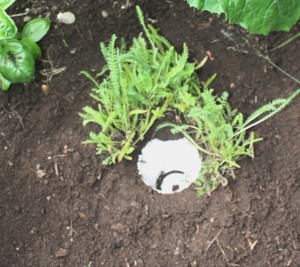 |
| A pitfall trap with Yarrow planted around it. |
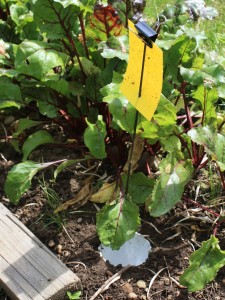 |
| My “control” pitfall and sticky traps. |
For the pit-fall traps, we are instructed to only count the beetles, and to compare the beetles we see to an identification guide we are provided. Our main target are ground beetles of the Carabidae family. These guys eat many common garden pests like caterpillars, aphids, and slugs. Identifying the genus of the beetles we catch is the fun part of the exercise. The sticky traps have to be counted by experts working with microscopes back at the lab, so we just collect and catalogue those.
 |
| One of the beetles I trapped and counted in week 1. He was subsequently released. |
There are UNIBUG volunteers across the Lower Mainland (keeping Dr. Ronnie running around keeping things running smoothly!), and here in New West, we have volunteers with yard gardens (like me) and several volunteers at each of the City’s three Community Gardens. With us all entering data on-line every week, and collecting stickytrap each week, I see a lot of lab time crunching data in Dr. Ronnie’s future. We get the fun part, she has to do the grunt work. The glory of a career in science!
Bugs in the Garden – UPDATE
This has been a tough year for the garden. A cool wet spring had a lot of our seeds dying in the ground. The weather also brought us slugs, snails, and aphids. The first crop of lettuce expired, as did the first attempt at carrots. The beets and radishes got eaten by slugs. Radishes wormed-through. I am a terrible gardener.
??
 |
| By the Middle of June, not much was happening. Besdies the Garlic and the two “vounteer” potatoes, everything seen was transplants sprouted inside. |
??Besides the weather, a constant issue in my garden is the combined aphid-ant battle. I learned last year that some species of ants actually farm aphids. The aphids apparently take more sugar-filled sap out of some plants than they can digest, so they…uh… pass a very sugar-rich waste that the ants harvest. Ants “milk” the aphids like we do cows. This is so successful that the ants have actually learned to farm the aphids. They move small aphids from one part of a plant to another to spread around the feeding space, they even defend the aphids from predators. My attempts to dissuade the ants from my plants, using tanglefoot on my blueberries, and diatomaceous earth on my sunflowers, were to no avail. Using a spray-bottle or water to knock the aphids off was pretty effective, until the ants replaced the lost flock with more young aphids. I just don’t have the time to do it every day. I’m a terrible gardener.
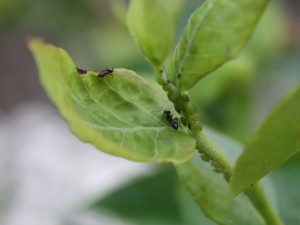 |
| Ants and aphids working together to kill my bluberry plant. (click to zoom). |
The problem with using anything more powerful (even insecticidal soap) is that it tends to knock down the natural enemies that control aphids and ants and other pests. The natural enemy of the aphid is the lady bug. So every time I see a lady bug in the garden, I know it is on my side. My experiences with ladybugs this year have included the whole life cycle.
Back in June I found a bunch of ladybug eggs on one of my sunflower plants:
Not long after, I found a bunch of freshly-hatched ladybug larvae on a leaf on my pepper plants:
Problem is, my pepper plants are amongst my tomatoes on the hot back deck, and the only two plants not being nuked by aphids. So I took matters into my own hands. I clipped the leaf off the pepper plant and attached it with a twist-tie to an aphid-infested blueberry plant in my front yard. I hoped the larvae would find a quick bounty, and stick around the garden patch where they were most needed.
That is where I learned about the ants and their defensive skills. 10 minutes after moving the leaf, there were a half dozen ants on the leaf, attacking the freshly hatched larvae. Oops. I moved the leaf to safer spot, and hopefully some of them survived! When they get big enough to defend themselves, the larvae are pretty cool looking:
And I can announce now that the weather has turned, there is a good population of ladybugs in my garden, and the aphids are almost gone completely. I still see a lot of ants around, and the sunflowers seem to have some aphids, but they are big enough to defend themselves, and they seem to be just populous enough to keep the ladybugs fed.
Oh, and now that the weather has turned, the garden is booming. Too late to get too much off the tomatoes this year I expect, but the beets, carrots, cukes and zuchs, the garlic, the blueberries, the potatoes and the onions seems to be going gangbusters, and the herb garden is loving the summer. We may even get a pumpkin to survive. Unfortunately, lettuce has been hit-and-miss this year, after a really successful last season. I really don’t know what I am doing. It sure is fun learning.
It looks like about two weeks until Fig Season, the greatest week of the year.
I am also taking part in a community science project being sponsored by Douglas College’s Institute of Urban Ecology, but I’ll talk about that later. If you are on Facebook, you can check it out now.
First update: That picture at the top shows what the garden was like inJune, with the late start, here is what it looks like now:
Second Update: I did a little research into Lady bugs, and I am supposing that little bug I photographed above is actually not a native ladybug, it is likely Harmonia axyridis, or a Japanese multi-colour ladybug. OK, because they eat a lot of aphids. but bad because are apparently displacing native species that might be better adapted to our climate. An interesting peice of background on native vs. introduced ladybugs. good reading!.
Good news?
Lest I am seen as always writing negative stuff here, bitching and complaining about the state of our environment, I thought I would point out some local positives today. (back to complaints tomorrow…)
It is great to read that City Hall (both the elected folk and the Staff) are publicly saying what much of the public has been saying since the UBE situation first cropped up last year. The end of the UBE and the indefinite future of the NFPR could have very positive consequences for New Westminster. Instead of our waterfront being defined as a through-fare for trucks moving containers from “Port Facilities” to places like Port Coquitlam and Port Kells and Port Mann, it can be a place where businesses grow, where people walk, where taxes are paid, and where the Downtown meets the waterfront. (Notably, this can all be done without spending a billion dollars putting vehicles in the fancy tunnels that would only result in increased traffic chaos at each end). Think the Quays of Old Port Montreal or the Peoria Waterfront, (which both have rails near the waterfront) or Spokane, or any of a dozen other examples of cities that have reconnected with their River Waterfront.
Then this rather fanciful story comes out. It looks very preliminary, but there may some real niche markets for this service. Driving from PoCo by the old Gillnetter Pub to the Canada Line in Richmond is only 35 km by road, but takes the best part of an hour during rush hour. The same trip by Transit takes a bus, Skytrain and Canada Line, and more than an hour and a half (and a three-zone fare). The same trip by high-speed catamaran, about 25km of River, could take less than an hour.
But yes, it is preliminary. I wonder what the economic reality is, with it apparently costing $1000/hr to run one of these boats, and an estimated (by me) seating capacity of 100 people, you need to charge $10 for a one-way trip to break even, and sell out every trip. I also wonder about how fast the actual ferries could go. There are off-the-shelf cats that can do 25 knots (~40 km/h) in good conditions, but the Fraser is both narrow in places and laden with logs and other debris. Popping a 3-foot diameter log at 40 km/h is going to be a bad day for the engineer in charge.
As a mass transit system, this might be wanting. As a niche market to connect poorly-connected hubs, there is potential. But I wonder what those hubs are…
But funny how we don’t think about the transportation markets that already operate on the River. I was sitting at the beer garden during Fraser Fest, listening to The NWSS band play some kicking R&B (I do love a 4-piece horn section), and I noticed this guy leaving the Southminster Dock in Surrey. They run barges of trailers to Vancouver Island a few times a day. Each barge carries 40 or so trailers. No doubt a more economic approach than having 40 trucks and drivers sitting in a BC ferry line-up.
I also a saw a barge load of rock rip-rap, enough to fill 100 trucks.
And a barge full of sorted gravel, enough to fill another 100 trucks.
3 tug boats doing the work of 240 trucks. This is the future of our waterfront, folks.
Finally, researching this topic, I ran into a new (to me) blog in New Westminster. I don’t know who this guy is, but it looks like he has been at it for a while, and he recently quoted Phil Plait, so he must be a gentleman and a scholar. Go over there and give him a read and a comment. We can forgive him for being from Toronto; you can’t choose where you are born, you can only choose where you live!
we might have made a big mistake…
It seems the City of New Westminster has decided to move towards single-stream recycling. This means that we will no longer be separating our paper from our plastics and containers, and will be throwing it all into one bin. The bin will be exactly like our existing black (garbage) and green-lid (organics) bins, and will be designed to be picked up by the same trucks.
At the time these ideas were floated, there was little feedback from the public. I didn’t comment at the time, as I felt that I was simply not informed enough to make a useful judgement about the merits of single-stream. I actually had lunch one day with the City’s Supervisor of Solid Waste, hoping he could explain the costs and benefits of going that way. It was clear to me after that meeting that I still didn’t fully understood the issue.
I was present at City Council on April 4 of this year when Allen Lynch , a New Westminster resident and Manager of North Shore Recylcing Program pleaded with council to not go down that path, but to consider the longer-term cost and sustainability implications of Single Stream Recycling. At the time, his issues seemed real, and I was happy to hear council direct Staff to address these concerns (most of which admittedly went over my head). I was equally happy to read a report from staff a month later that seemed to address all of the issues raised by Mr. Lynch. But it still stuck in my craw that somebody with a lifetime of professional experience managing recyclables was so convinced that the City was taking a wrong path going to single stream, and the main benefits to it were explained to me as saving money on trucks. When I feel underinformed, I tend to rely on experts in the field to explain the situation, and for the fourth time in this post already, I will admit I was not well-informed enough to take a position.
There was also quite a bit of discussion with the TrashTalkers group at NWEP, with some seeing the benefit of increased diversion promised by the Single Stream, and loving the idea of going to fortnight waste collection once it comes in, while others lamented the loss of 20 years of effective Community Based Social Marketing around the use of Blue Bins – we have taught a generation to separate recyclables, and recognize the differences in materials, are we going to lose some of that? Again, there were enough sides to this issue that the TrashTalkers could not come up with a consensus opinion, and therefore stayed out of the public debate.
I realise now that was a mistake. I should have met with Helen Spiegelman.
Tuesday, I attended a meeting of Zero Waste Vancouver, where Louise Swartz of Recycling Alternatives and Helen talked about single stream recycling, and the future of Extended Product Responsibility (EPR) programs in BC. It was a too-short 90 minutes, with a lively discussion amongst the participants, and I walked away with much of the information I was so lacking during my earlier ruminations on Single Stream Recycling.
Not to bury the lead; neither Helen (who has been involved in recycling and EPR programs since they began in the 80’s) nor Louise (who runs a very successful small business collecting recyclables from businesses and institutions) think that the move to single stream a good idea, for numerous good reasons.
Let’s see if I can summarise.
The justifications for going to commingling can be broken down to three “C”s: Cost, Convenience, and Capture. You can find them all mentioned here.
Cost is usually up front, and seems to be the main motivation behind New Westminster’s shift. By commingling recyclables, the same truck can be used for recycling as is used for trash, they just hose it out between loads. Therefore fewer vehicles are needed , and fewer crews to run the vehicles. The crews never leave the truck, so you only need one person per vehicle, and no-one is out in the rain physically tossing the recyclables. There is, of course, an upfront cost to buy the bins and the upgrade the trucks ($1.3 million in the case of New Westminster) , and there will actually be a small increase in the fee charged to residents (to cover the cost of the carts), but the City will save money in the long run, if all the other assumptions in the projection hold up.
“Convenience” is the assumption that separating your recyclables is a big hassle. I guess it is hard to argue that tossing everything in one bin is more convenient for the homeowner (… ugh….)
“Capture” is related to this. The assumption is that by making recycling more “convenient”, people will do it more, so a higher percentage of the recyclables will be captured, and diversion rates (the stuff at your curb that doesn’t go to the landfill) will go up. This has been measured in places that have gone to single-stream, and there is usually a slight increase in the percentage of materials going into the blue bins compared to the black bin (in the order of 5-10%).
Now let’s look at the alternative view on these three points:
The Cost savings are amortized over 20+ years, and are based on a lot of assumptions about fuel costs, about how we as a society are going to manage our waste, about where tipping fees are going, and about the future of recycling technology, markets for recycled materials, and producer extended product responsibility (EPR) programs. This is without even getting into the sustainability arguments around externalized costs relating to the down-cycling of materials and the loss of valuable materials, but let’s save that for another day, as this is already too long a rant.
The convenience gains are frankly ridiculous in New Westminster. Currently, the City asks that you separate your “garbage” (black bin) from your organics (green bin) and your recyclable containers and paper (blue box). We further ask that you separate your clean paper and newsprint from your containers by putting it in a blue or yellow bag along with your blue box. With commingling, you will still need to separate your “garbage” from you organics, and put your recyclable containers and paper in a blue bin. The only difference is that you can toss your paper in with the containers without having to put them in the bag first: hardly a massive time saver, and hardly a saving of hours of careful thought as people look at an object and wonder if it is a newspaper or a plastic container. So the increased convenience is a marginal gain at best.
However, what we lose by gaining this convenience is huge: and this is where the big lie comes in. Theoretically, there is an increase in “capture”; people will recycle more due to a mostly imaginary increase in convenience. However, this gain at the curb is very quickly lost at the Material Recovery Plant (MRF), and now we enter the murky world of Residuals.
Your recycled materials, either out of your blue box (plastic, metal and glass) or your new commingled blue bin (plastic metal glass and papers) go to an MRF to be sorted. (if you paper went in a blue/yellow bag, it is alreadt separared, so it goes through a separate process). At the MRF, the metal is removed using magnets and/or density-sorters, and the plastic and paper are sorted partially be mechanical means, and partially by hand. I wrote last year about touring one of these facilities in Iowa, but our MRF is in Surrey. Your recyclables are separated and bundled for shipping off to wherever they will be reprocessed (which is another whole separate Blog topic). At least most of it does. Some of the material that shows up in the MRF is not recyclable, either because it didn’t belong in the recycling in the first place (plastic bags, PVC, wood, BeeGees cassettes, etc.) or because it has been so contaminated and mixed with other materials it cannot be recycled (think a newspaper pressed up against a half-empty yoghurt container in the collection truck compactor). Depending on who you ask, and how you count, the residual rates in the MRFs can range from 5% to 50%. That is a big range. Clearly, even the most modest residual rates will offset any increase in “capture” you got from increased curb-side use. It also does not include the “down-cycling” component, that is the material that comes out of the MRF as much lower quality than it went into the blue bin, and consequently, cannot be used again for its original purpose.
The worst part is this residual rate going up (the 50% end oft he range as opposed to the 5% end) is largly the result of mixing fibre materials with containers, which is the only result of the New Wesmtinster’s commingling initiative! Of the materials being collected for recycling, paper is the one material that is at highest risk of being contaminated by other materials, and it is the material whose value as a commodity in the recycling market is most closely tied to its quality. A few shards of glass or a single sheet of soft plastic can turn a Tonne of paper fibre into a liability for the receiver, and can be stripped of its entire value. This is why the City currently asks you to separate your paper from the other products in the Blue box.
But it gets worse. I don’t know if anyone noticed, but Allen Lynch was quick to point this out at New West Council. As of May, 2011, The Province of BC added “packaging and printed paper” to their EPR regulation. That means that all packaging materials and all printed paper will be managed through an industry-led extended product stewardship program, the same type of program that now makes the producer responsible for refillable bottles, cans, tires, computers, paint, and all those other things you can take to a recycling facility and dispose of at no cost to you (because you paid for the recycling when you bought the product). What does this mean for the commingled recycling? Will the City get paid to collect the paper? Will the city send a bill to the EPR program operator (Encorp, or whomever)? Will all packaging (recyclable plastic and non-recyclable plastic, including films and blister packs) be mixed in with the paper? If so, how will we separate them? Simply put, the answers to these questions arw not known yet. The main point Allen Lynch was trying to make in April was that it may be irresponsible to throw a lot of money down this path until we know where it is going!
OK, one more point, just to throw gas on this fire. What happens to these MRF residuals? Traditionally, they go to the landfill, like the rest of your black bin trash, or potentially into the new incinerators that the region wants to install. However, with increased diversion, with an EPR program on packaging and paper, with organics in the Green Bin, there will continue to be less and less black bin trash. The fuel source for these incinerators is going away, even before they are built. However, residual waste from the MRF is excellent incinerator fuel! With the organics and wet materials out of it, it is low moisture, with the metal sorted out at the MRF, you are left with paper mixed with plastic film, heavy plastic, and a bit of broken glass: this shit will burn great! This I where the cynic says: The entire commingling move is a back-door way of diverting otherwise-recyclable materials to incinerators!
People who know me know I am not a conspiracy theorist, I always default to Hanlon’s razor. However, the implications of commingling are both unclear (in the real costing and in the fact that the metrics for diversion vs. residuals are very muddy from any City that has gone that way), and crystal clear (what the fate of the materials you put in your blue bin will be). The case for commingling is so poorly made, that I am waiting to be convinced that there is a sustainability component that I am missing. And while I wait, we are spending millions buying trucks and building incinerators.
I will come back to this theme in later posts. Mostly, I am confused about what we do next to deal with this issue. In New Westminster, we will be moving to commingling in 2012 unless we can prove to the Council prior to the November election that this is not the way we want to manage our recyclables. It is also an open secret that our Mayor is very interested in having a garbage incinerator installed in our City, in spite of the loud and ongoing public opposition to the idea.
To be continued…
My first actual Tree-huggin’ post
 |
| Tree protection? |
?????????During the recent Royal City Farmers Market fundraiser at the Heritage Grill (great time again, you guys!), I had a short chat with Councillor Lorrie Williams. Somehow the conversation gravitated to Tree Protection Bylaws. This is a topic that has come up several times at NWEP meetings over the last couple of years, and the NWEP members who serve on the City’s Environment Advisory Committee have mentioned that it arises occasionally at their meetings. There are a few people in New Westminster who have been advocating for this type of protection in recent years, Bill Zander amongst the most persistent. But there has been a push-back from City staff (mostly around cost and logistical issues- admittedly there is not much point having a bylaw if they cannot enforce it!) and even from a few members of Council.
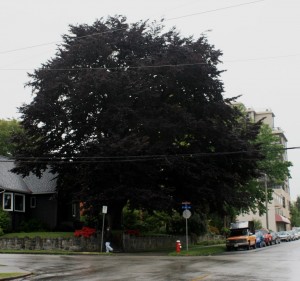 |
| An historic beech tree in my neighbourhood. |
I had a conversation at one of the fall’s TransLink open houses with another Councillor (who shall remain nameless to protect the cornered), and the topic of laneway housing came up. (S)he was concerned about the loss of green space, rainwater infiltration, etc., that might result if we overbuild our single-family lots. I agreed and suggested we shouldn’t allow laneway housing until we have a strong Tree Protection Bylaw. The Councillor’s response was to take a bit of a double-take, then bemusement that I had trapped the Councillor that way. (S)he then offered a rather meek “we have lots of trees”. The conversation ended shortly after.
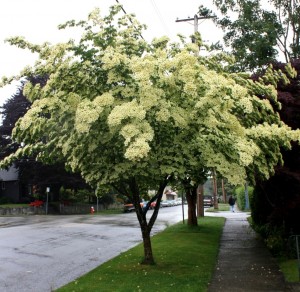 |
| The beautiful dogwood in front of my home. |
So I was pleased to hear that Councillor Williams has decided to bring this topic back to Council, and I decided to delegate to Council on the topic on Tuesday. No cameras were there, so I thought I would relate what I said for the record here.
Note that at Council, and in the excerpt below, I am speaking on behalf of the NWEP. The message below reflects the conversations the NWEP membership had at meetings, and the Directors of the NWEP unanimously approved my presenting this address to Council on behalf of the Group. Pretty much everything else you read on this Blog is my personal opinion, and is not necessarily the opinion of the NWEP or its members. Just so we are clear on the distinction.
The NWEP have discussed the issue of Tree Protection at length, and at our most recent meeting, agreed that a Tree Protection Bylaw for New Westminster was timely.
On many environmental, social and economic sustainability areas the City of New Westminster has taken a leadership position. However, this is an area, the protection of trees and our Urban Forest, where we have unfortunately been laggards.
Tree protection bylaws of varying strength are already in force in Vancouver, Burnaby, Surrey, Richmond, Delta, WhiteRock, North Vancouver , Coquitlam, Port Coquitlam, Port Moody, Maple Ridge, the Township of Langley, Victoria, Saanich, Nanaimo, Toronto…..well, the list goes on across the province, and across the country.
These bylaws vary in both their protection measures and the complexity of their implementation, but it is clearly within the Municipality’s authority to prohibit or regulate the cutting or damaging of trees, or to require that trees be replaced. Further, they all take into account the hazards caused by dangerous or diseased trees, and many designate significant areas (such as riparian areas around streams) or specific species or trees of historical value for special protection. Many use permit structures to become revenue-neutral.
I guess the point is we are not reinventing the wheel here, nor are the NWEP asking for New Westminster to be an exception. Tree Protection Bylaws are becoming standard practice in Canada.
The reasons Cities are establishing these bylaws are varied. Some Cities are rapidly developing and are concerned about habitat loss and the wholesale removal of forests at their edges. Others are concerned about greenway preservation and riparian protection for salmon-bearing or other ecologically-important streams in their districts, or are worried about slope stabilization in hilly terrain, or establishing green buffers between zoning changes.
However, most Cities simply recognize that trees play multiple roles in the 21st Century city. They shade buildings to provide energy savings; They buffer urban noise to make for a more peaceful environment; They filter CO2 and particulates out of the air while providing oxygen and acting as both humidity and temperature stabilizers in extreme weather; They absorb rainwater and reduce the load on stormwater drainage systems; They provide habitat for songbirds and other wildlife; They block light pollution and soften the “sharp edges” of a built-out urban environment. There is some evidence that trees actually prevent crime!
Here in New Westminster, trees provide all of these benefits, but additionally, we have our own specific reasons to have a very protective bylaw here. As one of western Canada’s most historic cities, it seems remarkable that we do not have a firm law protecting these historic landmarks. In my Brow-of-the Hill neighbourhood, there are several exceptional and well-preserved century-old trees. The loss of these remaining giants would be a loss for the entire community – but it is only to good grace of the current owner that protects this important natural heritage. Unfortunately, these examples are becoming fewer and far between as multi-family dwellings and densification have eroded our tree inventory over the last 50 years.
Development puts pressure on the City’s tree inventory. And densification is clearly the way of the future. With New Westminster a signatory to the new Regional Growth Strategy, it is clear that New Westminster will become a more “compact” Regional City Centre, in order to accommodate the extra 40,000 people projected to live in our City by 2041. With this densification, the pressure will be on to replace single lots where our trees need protection the most with townhouses or multi-family dwellings and the normalization of laneway housing. Make no mistake, I think these changes can be a positive thing for building a more energy- and transportation-efficient housing stock, and are imperative if we are to build a more durable and sustainable community. However, these changes raise significant concerns about the preservation of remaining natural greenspace, about managing rainwater infiltration so we don’t overwhelm our stormwater infrastructure, and yes, maintaining the myriad benefits of trees. A Tree Protection Bylaw will not solve all of these problems, but it is an important first step to assuring the next generation will receive the same environmental, social, and economic benefit from tress that we do.
Trees are often removed to “improve property”, with no need to replace them. Note three trunks in this pic that were large fir trees a year ago.
This lot on 8th Street used to have two single family houses, and trees. For these reasons, the NWEP believe that the time is now for a protective tree bylaw in New Westminster, and we call upon City Council and staff to work towards developing a Bylaw that suits the City’s specific tree protection needs.
After my presentation, the Councillors asked a few questions, but seemed very receptive to the idea. Mayor Wright seemed the most cautious (his standard “we need to consider many things here….” line), but I did emphasize that there ware lots of resources available on line and through inter-governmental discussion groups, there are many Cities that have these bylaws, and I have confidence that City Staff can find the right mix of protection for the City. I also offered any help the NWEP could provide in researching tree bylaws, and in helping with public education campaigns about the value of trees in our urban environment.
Later in the Meeting, Councillor Williams’ motion was read:
“WHEREAS trees are essential to air quality, esthetics and quality of life;
BE IT RESOLVED THAT New Westminster develop a Tree Retention / Removal Bylaw for both public and private property.”
The motion received unanimous support of the Council (Councillor Harper not present).
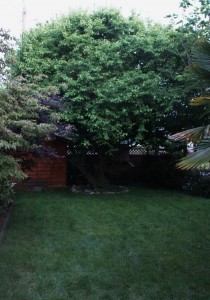 |
| This decades-old Cornellian cherry dogwood dominates my back yard, but it isn’t going anywhere on my watch. |
Community -updated!
I had such a fun weekend. One that reminded me how much I love my community.
I just want to add the note that back in December, I did an interview with the News Leader, and made my predictions for the 2011 Stanley Cup Playoffs. OK, I said Canucks-Habs, but Boston are an original six team that needed 7 games to knock Montreal out, so I’ll call that predition 75% accurate.
Friday evening was spent in Downtown Vancouver with some great friends, performing an unusual ritual for a life-long Canuck fan: drinking beer and watching hockey in the month of June. The sounds of the crowds downtown when the goal was scored, and when the final buzzer sounded, were amazing. I was lucky enough to be downtown during the Olympic Gold Metal Game as well, and the feeling was much the same. To be in amongst a crowd of tens of thousands, everyone throwing high-fives as they walk the street, the feeling was electric. Lots of cops in the crowd, but much like the olympics, they were present to make us feel secure, not to “keep order”, and they shared as many high-fives as anyone else. It was a great time.
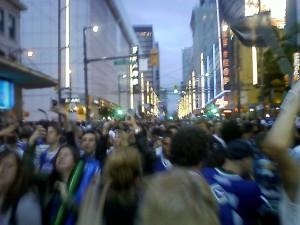 |
| It wasn’t the camera – it was actually this blurry out. |
It is silly to try to explain it. Generally and really large crowd of like-minded individuals is inherently a dangerous thing, but the feeling was so positive. Why? Because, as XKCD so eloquently put it, a weighted random number generator just produced a new batch of numbers. Why care if the Professional Sports Franchise in my hometown is superior to the Professional Sports Franchise in another town? Is the only benefit to all the time and energy we put into ultimately meaningless entertainment just about feeling good, collectively, once in a while? Is this a better way to spend out time an energy than curing cancer or writing piano concertos? Is this community building?
Saturday was mostly a garden day. Putting out a lot of the plants that I started indoors: the peppers, the tomatoes and the cucumbers, along with a few squash plants I was gifted from a friend. The radishes, lettuce and spinach are already out of the ground and into my salads, but with the cool spring we had, everything is starting late, and I have to fight the slugs, aphids and cutworms for every leaf. More bloggin on this to come, an ongoing summer project.
Finally, Sunday was spent at Sapperton Day, and it went off great. The event itself was incredibly well attended, the bands were great, the food was great (mmm…pulled Pork sandwich from the Crave/Ranch), and it was great to connect with many people I only see during summer events.
The NWEP booth was well attended, and there was lots of great discussion about the future of transportation in New West, post-UBE. We had a “blank map” to allow people to attach post-it notes with ideas about transportation in the City – What works, what doesn’t, pet peeves and points to ponder. Hopefully ,we can use this blank slate to collect ideas at all the summer events we are attending this year. It was great at facilitating conversation, and lots of great ideas were placed on the board. Notably, not all were NWEP member ideas, or even ideas the NWEP would endorse! The point was to start people thinking about transportation, as the City is getting into its Master Transportation Plan process. We hope that by starting the conversation, people will be informed and curious when the public consultations start.
But mostly Sapperton days is about getting together in the community to meet neighbours, catch up with friends, make new friends, get a little sunburned and have fun. Again, it is all about people coming together to community build.
…and have a little fun along the way.
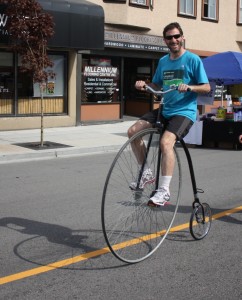 |
| NWEP’s cycling wildman and Ryan Kesler look-alike Pete taking a few turns on his new bike? |
Sapperton Day this Sunday
The Summer Festival season is upon us. We don’t have “Car Free Days” per se in New Westminster, but there are a few days when we close roads and let people gather on the streets. It is always a great way to meet your neighbours, re-connect with people you haven’t seen in a while, and remind yourself how we are a small community within a large City.

However, for the NWEP, festival season starts with Sapperton Days , as we are setting up our booth and doing some outreach to the community.
This year, we are talking transportation. The reasons should be obvious to anyone who has been reading this blog (hi mom!). With the UBE dead, with the future of the NFPR in doubt, with questions about the future of the Pattullo Bridge, and with the City starting its Master Transportation Plan process, now is the time to talk about transportation issues in the City.
So the NWEP will be there sharing our perspective. Our Transportation Group has established a set of ideas and principles that the group can support, based on our vision for the City and our research and consultation with regional transportation experts.
However, these community events aren’t about us preaching to an audience, they are about exchanging ideas. The main point of our booth is to listen to what the community thinks, and where the community is going on this issue. We hope that our ideas will be the starting point of conversations and will raise the topic so that more people get engaged in the public consultation around the Master Transportation Plan.
As such, we will be asking lots of questions about what you want to see in the City’s Master Transportation Plan. These are the “big ideas”: do we want to build more roads to move more traffic? Do we want to make the streets safer for bicycles and pedestrians? Can we take better advantage of our Transit opportunities? Can kids safely walk to school in New West? Can people with disabilities safely cross a street?
We will also be going smaller-scale. We hope to have a map where you can attach your ideas, where you can point out the “good, bad, and ugly” of New Wesmtinster’s transportation system. That intersection that just doesn’t seem safe, the area under-serviced by transit, the traffic light that doesn’t make sense or the crosswalk no-one seems to stop at.
So I hope to see you there Sunday. Make sure you show up in time for the Pennyfarthing Races, it is a highlight of Sapperton Day for me.
Just for fun, and to start a discussion, here is a collection of Myths about transportation I prepared for our booth (these are my opinions, and not neccessarily the NWEP position on these points). These are common conversation points that come up when we start talking about sustainable transportation to an audience that sees the world through a windshield. Don’t agree? Come down on Sunday and give me a hard time. I’m the guy with the 4th Round playoff beard.
Myth: The best way to fix traffic problems is to build more or better roads.
Evidence clearly indicates the opposite is true. No-where in the world has road building acted as anything more than a temporary solution to traffic congestion. Many large cities around the world (New York, London, San Francisco, Seoul, etc. etc.) have solved intractable traffic problems by reducing road space and investing in more rational alternatives. Others (Los Angeles, Seattle, Shanghai, Tokyo) have continued to build and expand roads, only to find them soon swollen with cars.
Myth: “Sustainable Transportation” means we will all be forced to ride around on bikes! You can’t move products to stores on bikes!
Sustainable transportation needs to include multiple choices for transportation of people and goods, and the most carbon-and space-efficient should be made the most cost-efficient. By moving people towards mass transit or “active transportation” like walking or cycling, and long- and medium-haul freight movement towards rails and ships, we make better use of existing roads to move goods to the stores more efficiently!
Myth: The traffic is going to come whether we build for it or not!
Traffic expands to fill space available. This is incontrovertible, and has been demonstrated around the world. “Rush Hour” traffic is caused by landuse planning built around the automobile. We need to start building to encourage more efficient transportation. The only demonstrably effective way to reduce the noise, pollution, and loss of liveability related to traffic is to reduce the space that traffic can take up. If you build it, they will come.
Myth: Trucks caught in traffic are limiting our economic growth!
No-one has clearly demonstrated how our economic growth is slowed by traffic. Clearly, the movement of bulk and container goods by truck is still competitive compared to the alternatives (such as rails or short-sea shipping) or companies would not rely so heavily on them. However, the trucking industry (much like the private automobile) is heavily subsidized by all levels of government, while rails and ship operators are mostly on their own for all their infrastructure costs. Economic growth comes from a level playing field and robust competition between competitors, not by favouring the least carbon-and energy-efficient mode of transportation by externalizing many of the infrastructure costs to the taxpayer.
Myth: Roads are cheap, building alternative transportation is expensive!
This should be an easy one in a Province where we are spending $3 billion in road bridge and highway expansion, and cannot find $400 Million to “fill the gap” on the Evergreen line. But when you add up the amount of your taxes the government spends on roads, on traffic lights, on traffic cops, and factor in the “externalized” costs related to healthcare, oil company subsidies, air pollution and greenhouse gas emissions, environmental degradation resulting from road runoff into our rivers and loss of developable land to parking lots and road lanes, the amount you pay for insurance, car repair, and gas seems miniscule. Once transit systems are built, once urban development encourages active transportation, their maintenance and operation costs become very small fractions of the costs of roads. One reason transit so great in most European cities is that they didn’t waste their money on roads!
Myth: Cyclists don’t pay taxes for the roads they use, drivers do!
No tax exists in BC that specifically charges drivers for road use. Gas taxes and carbon taxes go into general revenue to pay for roads, hospitals, fighter jets, Stephen Harper’s Stanley Cup roadtrips, and gazebos in Tony Clement’s riding, not specifically towards road building (although a portion of the TransLink gas levy does go to road building). Your roads are built mostly by the municipality and the province, using a combination of property taxes, income taxes, and sales taxes. People who ride bicycles pay the same taxes as people who drive cars, yet use 5% of the road space. Pedestrians and transit users also pay all these taxes, and use less than 5% of the road space that drivers do. People using alternative transportation are in fact subsidizing the private automobile user, and most would strongly support a road tax that fairly charged drivers for their road use
Thank You TransLink, Thank You Sapperton
20 hours later, I’m still unsure how to view the announcement that the UBE and the NFPR through New Westminster are dead.
My first reaction was to thank the volunteers who spent countless hours working through the consultation process. This is the note I sent the UBE Google Group last night:
“Congratulations, everyone. It is refreshing to see a community come together, and to see those elected and/or hired to represent us listen to the community.
But let’s not forget, the end of the NFPR is only the beginning of the conversation. We still have traffic issues to deal with, we still have Braid and Brunette, we still have Front Street cutting us off from our waterfront, we still have an under-serviced industrial area. The City is just now starting on a Master Transportation Plan process that will set the City’s priorities for the next decade and on. I encourage everyone who got involved in the UBE consultations to stay involved in the MTP process.
And finally, let’s acknowledge TransLink for taking an honest approach to community consultation. They spent a lot of money and staff time to make this thing work, and in the end when they could not get the support of the community, they were honest about it, and chose not to challenge the will of the people. They deserve kudos for both taking the time to make the case, and for taking the time to listen to ours.”
So this post is about that last point (there will be lots of opportunity to discuss the earlier points later).
I want to thank TransLink for engaging in this process, and for actually listening to the community instead of dictating to the community. There were a lot of people who were quick to say this consultation was all a sham. An Anonymous commenter on this Blog as recently as yesterday suggested as much. The indefatigable troll “Rick” on Tenth to the Fraser has been counted amongst those suggesting the UBE was a done deal, and frankly, a lot of people at the consultations felt the same way during the process. I was not one of them.
I have been a pretty harsh critic of TransLink recently (including a letter in this week’s News Leader following up on their recent budget announcement), but they did the right thing here, and deserve kudos. I made the point last night to personally thank Vincent Gonsalves and Sany Zein for taking the time to listen to the community and for honestly recognizing that their vision and our community’s vision were not compatable.
I heard Ken Hardie on CBC radio this morning. His message was at times slightly off-putting. It will be heard by many as one small neighborhood (Sapperton), blocking “traffic progress” for the whole region. In reality, it was the entire of New Westminster that took part in the consultation, and the reasons the community was against it were not as simple as Mr. Hardie framed them. It wasn’t only about impacts on Sapperton, it was about taking a holistic approach to the traffic issues in New Westminster, it was about prioritizing highway expansion over more sustainable alternatives, it was about trying to do what no other jurisdiction has ever done: solve traffic congestion by building roads. Those are the messages that resonated in New Westminster, and those are the reasons the community did not get on board. It was the impacts on the neighborhood that brought the people out, but it was the lack of viable solutions that killed the project.
Unfortunately, Rick Cluff (who continues to view the world through a windshield) tried to paint this as a big defeat and failure for TransLink, and I do not think that is fair. I see this as vindication of TransLink’s approach to public consultation, and it goes a long way towards building trust in TransLink as an organization that is genuinely interested in the needs of Metro Vancouver.
More importantly, this is not a NIMBY issue. New Westminster wants TransLink to build Evergreen so that our under-serviced neighbouring communities can enjoy the Transit access that New Westminster already enjoys.New Westminster wants TranLink to build rail alternatives for the South-of-Fraser and the Valley, so that the need for more roads is reduced. New Westminster wants Translink and the Federal Government to spend our tax dollars on practical, useful infrastructure that will move goods and people, and support more sustainable community development. If that infrastructure spending is not in New West, that is fine with us, becasue the entire region benefits, and we are good neighbours.
There is temptation to say “WE WON!” and by extension to suggest TransLink lost. However, that is superficial. The victory here is for the process, and TransLink owns that victory as much as New Westminster does. The only people who lost were the people sitting on the sidelines, not taking part in the engagement process, and who will now, no doubt, start complaining about the decision that was made (see the comments on the CBC news item to see the Monday-morning quarterbacking already). The fact Coquitlam was essentially absent from all these discussions (they had 24 people show up at their UBE open house event, and most were from New Westminster) will hurt them if they try to claim injustice now.
